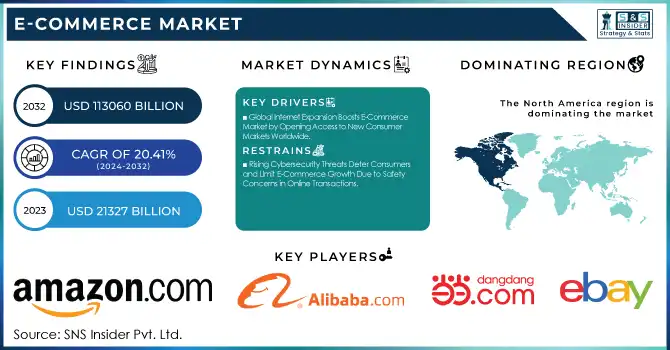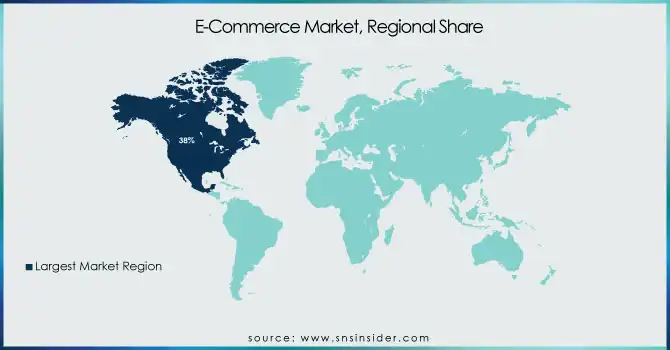E-Commerce Market Report Scope & Overview:
The E-Commerce Market was valued at USD 21,327 billion in 2023 and is expected to reach USD 113,060 billion by 2032, growing at a CAGR of 20.41% from 2024-2032. This report includes an in-depth analysis of consumer demographics, shopping trends, payment preferences, and e-commerce security trends. The market is driven by increasing digital adoption, shifting consumer behaviors, and advancements in secure payment methods. As the demand for seamless, personalized shopping experiences rises, businesses must adapt to these evolving preferences while ensuring robust security measures to build consumer trust and foster long-term growth.

To get more information on E-Commerce Market - Request Free Sample Report
E-Commerce Market Dynamics
Drivers
-
Global Internet Expansion Boosts E-Commerce Market by Opening Access to New Consumer Markets Worldwide
The rapid increase in global internet access plays a crucial role in the expansion of the e-commerce market. As more people around the world come online, a vast new customer base emerges, leading to greater opportunities for businesses to tap into previously underserved regions. The expansion of mobile internet access, especially in developing countries, has been a key factor in driving online shopping. With broader connectivity, consumers now have the ability to shop from anywhere at any time, breaking down geographical barriers. This trend is particularly evident in emerging markets where traditional retail infrastructure is limited, giving e-commerce platforms a significant edge in capturing new customers and expanding their reach across diverse regions.
Restraints
-
Rising Cybersecurity Threats Deter Consumers and Limit E-Commerce Growth Due to Safety Concerns in Online Transactions
This new trend in hacking and breach of data has had a toll on the e-commerce market as users are becoming more cautious of their online transactions. These users have increasingly become more conscious of fraud, greatly depriving the platform of potential customers who do not trust the system. Hackers toward their intended e-commerce sites usually target the domains lacking appropriate security mechanisms to compromise the sites and the user information therein. These security breaches may lead to exposure of confidential information, hence losing trust and resulting in reputational loss. Moreover, the continuing requirement for companies to alter their security controls increases the cost of business. This emerging issue of cybersecurity weaknesses is one significant factor that discourages potential customers and limits the growth of the e-commerce industry.
Opportunities
-
Artificial Intelligence Enhances Personalization, Boosting Customer Engagement and Driving E-Commerce Growth Through Tailored Shopping Experiences
The application of artificial intelligence in e-commerce is revolutionizing the shopping experience, providing significant potential for growth. By harnessing AI, businesses can offer personalized product recommendations, tailored advertisements, and dynamic pricing models that resonate with individual consumers' preferences. AI-driven algorithms analyze customer behavior and purchasing patterns, enabling e-commerce platforms to predict needs and optimize offerings in real-time. This level of personalization not only boosts customer satisfaction but also enhances engagement, leading to higher conversion rates and repeat purchases. Additionally, AI enables businesses to streamline operations, optimize supply chains, and provide proactive customer service, further elevating the overall shopping experience. As consumers increasingly demand customized solutions, businesses that incorporate AI will have a distinct competitive advantage in the market.
Challenges
-
Increasing Competition in E-Commerce Makes Differentiation and Customer Retention Challenging for Smaller Businesses in Saturated Markets
As more businesses enter the e-commerce space, standing out in a highly saturated market becomes increasingly difficult. This growing competition places pressure on companies, particularly smaller players, to differentiate themselves. With a vast number of online retailers offering similar products, it is challenging to capture and maintain consumer attention. E-commerce businesses must invest in effective branding, innovative marketing strategies, and unique value propositions to rise above the competition. Also, customer acquisition costs rise when more companies fight for the same target base. Small companies with fewer resources are unable to match larger companies' ability to pay for high-end advertising and operational efficiencies, thus finding it increasingly difficult to capture a large market share.
E-Commerce Market Segment Analysis
By Product
The home appliances segment led the e-commerce market with a significant revenue share of approximately 31% in 2023 due to the increasing consumer preference for convenience and online shopping. The rise in demand for smart home appliances and advancements in technology have fueled online purchases. Additionally, frequent discounts, easy comparison of products, and doorstep delivery options have further boosted consumer spending in this category.
The fashion products segment is poised to grow at the fastest CAGR of about 22.56% from 2024 to 2032, driven by the growing trend of online shopping for clothing and accessories. The convenience of browsing a wide variety of styles, easy returns, and personalized shopping experiences offered by e-commerce platforms are attracting more consumers. Social media influencers and targeted advertising also play a key role in driving fashion-related sales
By Model Type
The B2B segment dominated the e-commerce market with a substantial revenue share of approximately 69% in 2023, driven by large-scale transactions between businesses. Companies are increasingly turning to digital platforms for procurement and supply chain management, as these platforms offer cost efficiencies, streamlined processes, and access to a global network of suppliers. B2B e-commerce also benefits from bulk orders and long-term contracts, ensuring consistent growth.
The B2C segment is expected to grow at the fastest CAGR of about 22.82% from 2024 to 2032 due to the increasing shift towards online shopping among consumers. The convenience of browsing products, secure payment methods, and home delivery options have made e-commerce the preferred shopping choice. Furthermore, the rise of mobile commerce and digital marketing strategies has accelerated consumer adoption, fueling robust growth in this segment.
Regional Analysis
North America dominated the e-commerce market with the highest revenue share of about 38% in 2023 due to the region's advanced digital infrastructure and high internet penetration. Consumers in North America have embraced online shopping due to its convenience, variety, and the availability of secure payment methods. The presence of major e-commerce players like Amazon and Walmart, along with robust logistics networks, has further solidified North America's leadership in the global e-commerce market.
The B2C segment is expected to grow at the fastest CAGR of about 22.27% from 2024 to 2032, driven by the continued shift toward online shopping among consumers worldwide. The convenience of browsing products, competitive pricing, personalized shopping experiences, and quick delivery options are key factors contributing to this growth. The widespread adoption of mobile devices and social media platforms also enhances the accessibility and reach of B2C businesses, further accelerating market expansion.

Get Customized Report as per Your Business Requirement - Enquiry Now
Key Players
-
Amazon.com, Inc. (Echo Dot, Fire TV Stick)
-
Alibaba.com (Wholesale Electronics, Clothing)
-
ASOS (Men’s Hoodies, Women’s Dresses)
-
Costco Wholesale Corporation (Kirkland Signature Vitamins, Office Furniture)
-
Dangdang (Books, Electronics)
-
eBay Inc. (Smartphones, Vintage Clothing)
-
Flipkart.com (Smartphones, Laptops)
-
JD.com (Home Appliances, Smartphones)
-
Lazada (Electronics, Beauty Products)
-
MercadoLibre S.R.L. (Smartphones, Furniture)
-
Shopify (Website Builder, Payment Solutions)
-
Shopee (Toys, Home Decor)
-
Walmart (Groceries, Clothing)
-
Wayfair LLC (Furniture, Home Goods)
-
Zalando (Shoes, Clothing)
-
Ebates Performance Marketing Inc. (Cashback Offers, Coupons)
-
Best Buy Co. Inc. (Laptops, Cameras)
-
Groupon Inc. (Travel Deals, Local Services)
-
Inter IKEA Systems B.V. (Furniture, Home Accessories)
-
Otto GmbH & Co. KG (Clothing, Electronics)
-
Lojas Americanas S.A. (Books, Electronics)
-
Priceline.com LLC (Hotel Deals, Car Rentals)
-
BigCommerce (E-commerce Solutions, Website Templates)
-
SHEIN (Women’s Fashion, Accessories)
-
Carrefour (Groceries, Household Items)
-
Ocado (Grocery Delivery, Household Goods)
Recent Developments:
-
In February 2025, JD.com entered China's competitive food delivery market with JD Takeaway, inviting restaurants to join its platform with a commission-free offer for the first year. This move aims to challenge market leaders Meituan and Eleme while leveraging JD.com's extensive logistics network.
-
In May 2024, Reliance Retail announced a strategic partnership with ASOS to introduce the UK-based fashion retailer’s curated portfolio to India. The collaboration aims to offer ASOS's fashion labels through a multi-channel presence, including exclusive stores and online platforms.
-
In November 2024, Alibaba formed a new E-Commerce Business Group to integrate its various e-commerce platforms, such as Taobao, Tmall, and AliExpress. This restructuring aims to create synergies across global supply chains, enhance market access for small businesses, and leverage AI to drive growth and improve efficiency.
| Report Attributes | Details |
|---|---|
| Market Size in 2023 | USD 21,327 Billion |
| Market Size by 2032 | USD 113,060 Billion |
| CAGR | CAGR of 20.41% From 2024 to 2032 |
| Base Year | 2023 |
| Forecast Period | 2024-2032 |
| Historical Data | 2020-2022 |
| Report Scope & Coverage | Market Size, Segments Analysis, Competitive Landscape, Regional Analysis, DROC & SWOT Analysis, Forecast Outlook |
| Key Segments | • By Type (Business To Business (B2B), Business To Consumer (B2C), Consumer To Consumer (C2C)) • By Product (Home Appliances, Fashion Products, Groceries, Books, Others) |
| Regional Analysis/Coverage | North America (US, Canada, Mexico), Europe (Eastern Europe [Poland, Romania, Hungary, Turkey, Rest of Eastern Europe] Western Europe] Germany, France, UK, Italy, Spain, Netherlands, Switzerland, Austria, Rest of Western Europe]), Asia Pacific (China, India, Japan, South Korea, Vietnam, Singapore, Australia, Rest of Asia Pacific), Middle East & Africa (Middle East [UAE, Egypt, Saudi Arabia, Qatar, Rest of Middle East], Africa [Nigeria, South Africa, Rest of Africa], Latin America (Brazil, Argentina, Colombia, Rest of Latin America) |
| Company Profiles | Amazon.com, Inc., Alibaba.com, ASOS, Costco Wholesale Corporation, Dangdang, eBay Inc., Flipkart.com, JD.com, Lazada, MercadoLibre S.R.L., Shopify, Shopee, Walmart, Wayfair LLC, Zalando, Ebates Performance Marketing Inc., Best Buy Co. Inc., Groupon Inc., Inter IKEA Systems B.V., Otto GmbH & Co. KG, Lojas Americanas S.A., Priceline.com LLC, BigCommerce, SHEIN, Carrefour, Ocado |

